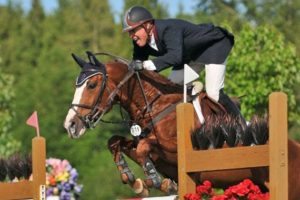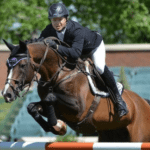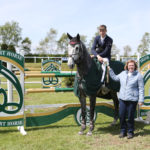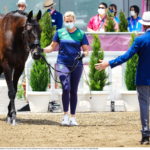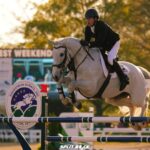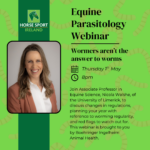Flexible, show jumping’s comeback king
- 27 October 2014, 23:44
SHOW jumper Flexible has proved that you can’t keep a good horse down, having overcome three potentially career-ending problems to remain at the forefront of international competition.
Now, the Irish Sport Horse is being honored with the Grayson Comeback Award, which will be presented during the National Horse Show at the Kentucky Horse Park in Lexington on Friday.
Flexible, owned by Sam and Mollie Chapman and trained and ridden by Rich Fellers, suffered three distinct and seemingly career-ending problems over a decade. They involved fracture, atrophy, and vascular blockage.
Yet, he overcame them all with expert veterinary care and Fellers’ own acumen, and this year at the age of 18 won the $55,000 Land Rover Grand Prix of Sacramento. Fellers has already begun making plans to qualify for the 2015 Longines FEI World Cup, which they won in 2012.
The Grayson Comeback Award is being presented by the Grayson-Jockey Club Research Foundation, an all-breeds organization whose mission is to fund veterinary research for the benefit of horses. Rood and Riddle Equine Hospital has also donated $10,000 to the foundation in Flexible’s honor.
Dr Tom Riddle of Rood and Riddle challenged Flexible’s fans to also contribute to Grayson, to further its program of funding research projects for the betterment of the horse.
The Grayson Comeback Award trophy will be accompanied by a $500 cheque to the groom and will be presented on Friday night during the Rood and Riddle Sport Horse Seminar.
Fellers acknowledged what an amazing horse Flexible has been over the years. In 2012, after winning the FEI World Cup Final, he was named the US International Horse of the Year.
Bred in Ireland by Edward and Catherine Doyle, and by the famous Irish Sport Horse stallion Cruising, the first of Flexible’s three career-ending issues began in the fall of 2003, when he was seven. “He started going very lame on his right front about 15-20 minutes into a ride. After a few minutes of rest he would be sound again. Needless to say, there were many different diagnoses from different vets. As he lost fitness over time the issue became more severe,” Fellers said.
“Late Summer 2004 we took Flexible up to Washington State University Vet School where Dr Robert Schneider went to work on solving the mystery. He discovered a blockage in the main vein that drained blood out of his right front leg. After numerous practice procedures on test horses he executed angioplasty on Flexible’s vein with little hope that it would help. Afterward, Dr Schneider advised me to take Flexible home and let him be a horse again. He would monitor his own pain while turned out by resting. We brought him home in early September and gradually started back to work.”
The next major injury occurred in the late summer of 2005. After a successful circuit in Calgary at Spruce Meadows, Flexible went to New York for two weeks of competition at the new HITS venue in Saugerties. During a rest week at Castle Hill farm in Brewster, Flexible fractured his left scapula in a grass paddock. He remained at Castle Hill for about six weeks until he was sound enough to load on a trailer and airplane to fly home.
” A couple weeks after returning home we noticed all the muscles in his left shoulder were atrophied. Diagnostic work revealed damage to his Supra-scapular nerve. He had a condition known as ‘Sweeney Shoulder’. In rare cases the nerve repairs itself and the horse recovers. Most cases the horse is a cripple for life. You know the outcome,” Fellers said.
Flexible’s most recent issue showed up in June 2013, when he was 17. “He started going very lame on his right hind leg 5-10 minutes into a ride. After a couple minutes of rest he would be perfectly sound again. This didn’t take long for my vet, Dr. Mark Revenaugh, to diagnose as the lameness pattern was very similar to that of the vascular blockage issue he overcame 10 years prior. This time it was clotted arteries to the right hind leg,” Fellers said.
With extensive diagnostics at University of California-Davis vet hospital, Dr. Monica Aleman was able to diagram all of the clotted vessels. The treatment options were: 1) A five and a half hour surgery to clean out the arteries that were accessible or 2) put him on a daily blood thinner to hopefully halt the clotting process so he could have a somewhat comfortable retirement.
“The experts all agreed that the existing clots would never disappear. We started Flexible on Warfarin upon his return home from UC Davis (end of August 2013). We gradually increased his exercise each week and never looked back,” Fellers said.
Edward L. Bowen, president of the Grayson-Jockey Club Research Foundation, said although the foundation was affiliated with the Thoroughbred industry, most of the research it funds was as helpful to all other breeds and activities as it is to racehorses.
“We like to call Grayson ‘The Friend You Can’t Do Without,’ and regardless of your specialized interest in horses we are there for you by funding research on laminitis, tendon and ligament issues, placentitis – the whole gamut,” he said.
The foundation, which relies on private donations, is funding 19 projects for slightly more than $1 million this year and since 1983 has provided $20.9 million to underwrite 310 projects at 41 universities.
“The ultimate benefits of equine research require various stages,” Bowen said. “We seek the best research projects available, but the expertise of research scientists is then handed off to veterinarians who must be up to date and willing to accept new science. Of course, the owner/trainer also has to be ‘flexible’ enough-so to speak – to accept change as well.
Article courtesy of www.horsetalk.co.nz
Related news stories
IRISH RIDERS MAKE THEIR MARK ON OPENING DAY OF FIVE STAR SPRUCE MEADOWS
- Popular

- Latest

Expression of Interest: Hosting a Leg of the Longines EEF Series (2026–2030)
Irish Sport Horses prove to be the choice for many of the top riders.
Sweetnam goes close in Kentucky GP as Swail is on the victory trail
Wormers aren’t the answer to worms – Equine Parasitology Webinar








